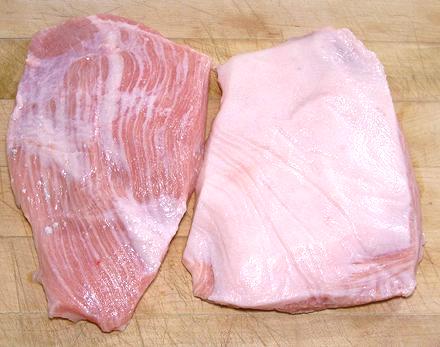 This is cut is from the jowl, with most of the fat removed - but not all
the fat. The jowl is below the cheek, which is right behind the jaw and
contains a big lump of very tough meat. The jowl contains a thin layer
of much more tender meat, and this cut is trimmed to the thickness of
that meat layer at its thickest.
This is cut is from the jowl, with most of the fat removed - but not all
the fat. The jowl is below the cheek, which is right behind the jaw and
contains a big lump of very tough meat. The jowl contains a thin layer
of much more tender meat, and this cut is trimmed to the thickness of
that meat layer at its thickest.
This is quite different from the more familiar cured products - the Hog Jowl Bacon of North America and the Guanciale of Italy. Both of those use the full thickness of the jowl, which is mostly fat. For those products see our Pork Products page.
The photo specimens were about half an inch thick, the largest was 6-3/4 x 5-1/2 inches and wighed 9-7/8 ounces. The photo shows both sides. The meat layer is not even so the constant thickness cut is nearly ll meat on one edge, and tapers to nearly all fat on the opposite edge.
More on Cuts of Pork.
The fat, of course, can be very easily rendered into useful lard. Do not fear the lard, it is far less dangerous than the deadly trans fats the AHA urged you to use instead, and you survived those (we hope). It tastes a lot better than trans fats too - for details see our Lard page.
ap_jowlmz 190909 - www.clovegarden.com